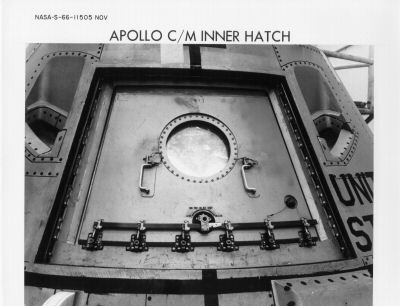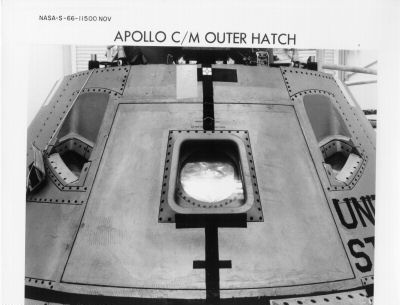Added 1 new A* page:I wanted to draw an old-school screw-opening hatch for this ship; for the most part I've used various types of sliding doors containment areas in A* to this point, which are easier to draw, but kind boring visually--also harder to show someone in the process of opening them. I suppose this is a secondary or inner hatch here. For some reason I'd been picturing it as an outward-opening hatch, but then I thought maybe I should check to see which way hatches usually go on space ships.
Apparently for space ships, hatch usually open out (and in for submarines). This seems unintuitive--which is why I looked it up--because if they opened the other way (in for a space ship, out for a submarine), pressure would help seal them shut--that kind of hatch is called a plug door. I'm not sure what set the precedent for submarines, but for space ships it was pretty definitely the Apollo 1 fire that killed three astronauts in a launch pad systems test in 1967; their pure oxygen cabin atmosphere ignited, and even if they had been able to reach the escape hatch, they wouldn't have been able to get out, because the inward-swinging hatch couldn't have been opened until the cabin pressure had been vented to match the outside pressure; after that, the US space program switched definitively to outward-opening hatches (ironically, one of the reasons the Apollo 1 had an inward-opening hatch was because one of the astronauts killed, Gus Grissom, had come close to drowning when explosive bolts on his Liberty Bell 7 ship in the Mercury-Redstone 4 mission (the US's second manned space flight, in 1961) had blown the craft's outward-opening hatch off unexpectedly after the ship landed in the sea).
Here are some photos of the inner (inward-opening) and outer hatch of the "Block 1" design used in Apollo 1:
 
images by NASA (source)
~~~~~~
Man I'm getting a backlog of news tabs again, gotta run through some of these. Let's see... A while back I posted about a NASA sting operation where they caught someone trying to sell a Moon rock--brought back by the Apollo missions, they're classified as "national treasures" and are not legal to sell, although President Nixon gave them as gifts to all 50 states, and 136 countries. Well, this article talks about a recent report released by NASA's inspector general, admitting that out of 26,000 space material samples given out on loan, "more than 500 pieces of moon rocks, meteorites, comet chunks and other space material were stolen or have been missing since 1970"; apparently they just didn't really keep track of them very well--samples would be given out on loan to researchers or institutions, who would keep them for decades, even allowing employees to take them home upon retirement. Oh well, lots more where those came from, I suppose.
And then over the past few days there's been a flurry of articles about the Earth having a "second Moon," which is a pretty impressive overreaction to a recent paper claiming that studies of the Earth/Moon system's gravitational field show that at any given time, there is probably an asteroid on the order of 1-meter across orbiting the Earth--not quite "Moon"-sized. These rocks supposedly take three or so spins around the planet over the span of about ten months before their momentum carries them back out into space. One such rock was spotted by a sky survey in 2006 (due to its bright color it was at first mistaken for an old titanium white Saturn rocket stage, a number of which are in solar orbit close to the Earth), and stayed in Earth orbit until 2007. Asteroids that small--and usually not so bright--are pretty hard to spot, even in orbit around the Earth, but according to this theory there's probably one out there now, buzzing around the planet.
|
